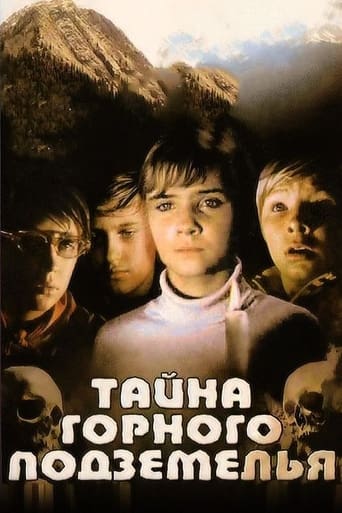



Very very predictable, including the post credit scene !!!
View MoreSorry, this movie sucks
Masterful Movie
Crappy film
"The Secret of the Mountain Cave" used to be rather successful when Hungarian movie theaters played it in 1977. Basically everybody in my generation had seen this movie and you could discuss it or admit liking it. (While generally it was considered uncool to like movies from the USSR, due to the hidden and not-so-hidden propaganda they contained more often than not.) And discuss we did, as the film is rather intelligent and thought-provoking.Now this is practically forgotten -- as I write this, there are only 8 IMDb ratings. (Although one can view it for free at YouTube; certainly the quality is not good there and the language is Russian only.) And seeing this again, I must admit that it is not for today's teens! For them the film would seem very SLOW and cheap, without any special effects (if we do not count some fake snow that is clearly foam from a fire extinguisher) and only one jump scare. There is no rude humor either. Maybe a remake will make the story accessible for them some day... But the original is still a decent survival movie for grown-ups, with exemplary character development and nice cinematography.The story: Four 13 year olds, three boys and one girl are on a school skiing tour in the Crimean mountains above Yalta. Not willing to wait two hours for the end of a boring ski jumping event, they decide to leave the group and take a mountain path back to camp. A sudden storm forces them to leave the open ridge and seek shelter in a cave. Inside they discover a secret cache and command bunker that used to belong to Hitler's Wehrmacht. Although cold and there is no fuel/electricity (only lots of candles, weapons, money and canned food -- everything is labeled but in German that they do not understand) the cave gives good shelter for one stormy night. The trouble comes the next morning when they try to leave, only to discover that during the night a landslide has closed the opening. Now they must find their way out before they either freeze or starve to death...From there the film takes a rather unique path. Unlike in Daylight (1996) or Metro (2013) physical force or acrobatic skills are useless here. Survival depends on intellectual and even moral strength. What should they use from the German stock and what is better left alone? How to decipher the German signs and should they believe them? What to do if one's decision affects the whole group's chances to live? Thus the strong but reckless Boris is gradually losing his leader's position to nerdy Marat, an unlikely hero who, while the other boys play with the weapons, is learning German from a found conversation booklet. (It was made to ease the invaders' communication with the locals, and practically contains threats of death penalty for almost everything. It is interesting to see how the booklet helps the children to really comprehend the nastiness of war and Nazism for the first time, although this is something they already knew well in theory.) It is also very remarkable how remembering pieces of advice from his parents helps Marat to come to good decisions -- unlike the majority of children's movies that overemphasize the value of independence and show the protagonists trying to solve their problems without any help from the adult world, which actually may give young viewers rather bad ideas.This movie came from a small studio, it's low budget even by Soviet standards and most contributors are B-grade -- but it is visible that the director, cinematographers and other people involved were used to such limitations and they really gave their best. (In this aspect this film resembles "The Aquanauts" 1979, although the two projects shared only a cameraman.) The opening credits are among the best I've ever seen: a shaky pseudo-amateur camera follows the winding mountain high road, sometimes seeking out the historical buildings and other interesting sights alongside it. (Certainly Soviet schoolchildren did not have camcorders in the 1970s but one can imagine the local TV studio having sent an intern to film the school trip for their newsreel.) A choir sings the theme song that sounds like a typical pioneer's song but it is neither propagandistic or overly patriotic, it is a lovely song about finding ourselves via nature and travel. At times the road enters dark tunnels (this is when the credits are shown), the march-like instrumentation turns to violins and an eerie atmosphere creeps in... While the camera-work is not equally imaginative during the rest of the film, it successfully gives the illusion of having been filmed by candlelight and electric torches only, but without too much disturbing candle-like flickering; also there is an interesting noir-like play of shadows at the decisive moments. And the score is using the same simple melody again and again, flexibly and unobtrusively. (It is worth to observe how agitated it gets at 01:01 when they dress a wound.)Marat's parents are the only professional actors (known from lots of supportive roles) and neither of these children have grown into an actor since then, but they did a good job here, speaking and behaving very naturally.
View More